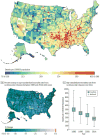Reducing Cardiovascular Disparities Through Community-Engaged Implementation Research: A National Heart, Lung, and Blood Institute Workshop Report
- PMID: 29348251
- PMCID: PMC5777283
- DOI: 10.1161/CIRCRESAHA.117.312243
Reducing Cardiovascular Disparities Through Community-Engaged Implementation Research: A National Heart, Lung, and Blood Institute Workshop Report
Abstract
Cardiovascular disparities remain pervasive in the United States. Unequal disease burden is evident among population groups based on sex, race, ethnicity, socioeconomic status, educational attainment, nativity, or geography. Despite the significant declines in cardiovascular disease mortality rates in all demographic groups during the last 50 years, large disparities remain by sex, race, ethnicity, and geography. Recent data from modeling studies, linked micromap plots, and small-area analyses also demonstrate prominent variation in cardiovascular disease mortality rates across states and counties, with an especially high disease burden in the southeastern United States and Appalachia. Despite these continued disparities, few large-scale intervention studies have been conducted in these high-burden populations to examine the feasibility of reducing or eliminating cardiovascular disparities. To address this challenge, on June 22 and 23, 2017, the National Heart, Lung, and Blood Institute convened experts from a broad range of biomedical, behavioral, environmental, implementation, and social science backgrounds to summarize the current state of knowledge of cardiovascular disease disparities and propose intervention strategies aligned with the National Heart, Lung, and Blood Institute mission. This report presents the themes, challenges, opportunities, available resources, and recommended actions discussed at the workshop.
Keywords: cardiovascular diseases; community-based participatory research; geography; social class; social determinants of health.
© 2018 American Heart Association, Inc.
Conflict of interest statement
Figures



References
-
- National Center for Health Statistics. Health, united states, 2015: With special feature on racial and ethnic health disparities. CDC, NCHS; 2016. http://www.cdc.gov/nchs/data/hus/hus15.pdf. Accessed. - PubMed
-
- Woolf SH, Aron LY. The us health disadvantage relative to other high-income countries: Findings from a national research council/institute of medicine report. JAMA. 2013;309:771–772. - PubMed
-
- Mensah GA, Mokdad AH, Ford ES, Greenlund KJ, Croft JB. State of disparities in cardiovascular health in the united states. Circulation. 2005;111:1233–1241. - PubMed
-
- Jones K, Mansfield CJ. Premature mortality in north carolina: Progress, regress, and disparities by county and race, 2000-2010. North Carolina medical journal. 2014;75:159–168. - PubMed
Publication types
MeSH terms
Grants and funding
LinkOut - more resources
Full Text Sources
Other Literature Sources
Medical

